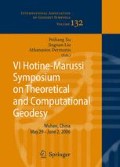Abstract
A new functional model is proposed for gravity field modeling on the basis of KBR data from the GRACE satellite mission. This functional model explicitly connects a linear combination of gravitational potential gradients with a linear combination of range-rate measurements at several successive epochs. The system of observation equations is solved in the least-squares sense by means of the pre-conditioned conjugate gradient method. Noise in range-rate combinations is strongly dependent on frequency, so that a proper frequency-dependent data weighting is a must. The new approach allows a high numerical efficiency to be reached. Both simulated and real GRACE data have been considered. In particular, we found that the resulting gravity field model is rather sensitive to errors in the satellite orbits. A preliminary gravity field model we obtained from a 101 day set of GRACE data has a comparable accuracy with the GGM01S model derived by CSR.
Access this chapter
Tax calculation will be finalised at checkout
Purchases are for personal use only
Preview
Unable to display preview. Download preview PDF.
References
R. Biancale, G. Balmino, S. Bruinsma, J. M. Lemoine, S. Loyer, and F. Perosanz. GRACE data processing in CNES/GRGS; results and discussion. In J. Ries and S. Bettadpur, editors, Presentation Proceeding of the GRACE Science Team Meeting at Center for Space Research, The University of Texes at Austin, October 13–14, 2005, pages 203–220. 2005.
K. Case, G. Kruizinga, and S. C. Wu. GRACE Level 1B Data Product User Handbook JPL D-22027 GRACE 327–733. 2004.
P. Ditmar, R. Klees, and F. Kostenko. Fast and accurate computation of spherical harmonic coefficients from satellite gravity gradiometry data. Journal of Geodesy, 76:690–705, 2003.
P. Ditmar, R. Klees, and X. Liu. Frequency-dependent data weighting in global gravity field modeling from satellite data contaminated by non-stationary noise. Journal of Geodesy, 81:81–96, 2007.
P. Ditmar and A. A. van Eck van der Sluijs. A technique for Earth’s gravity field modeling on the basis of satellite accelerations. Journal of Geodesy, 78:12–33, 2004.
P. Ditmar, and X. Liu. Gravity field modeling on the basis of GRACE range-rate combinations: current results and challenge. The Proceeding of the ’1st International Symposium of the International Gravity Field Service (IGFS): Gravity Field of the Earth’. p 181–186, Aug 28– Sept 1, 2006, Istanbul, Trukey.
C. Förste, F. Flechtner, R. Schmidt, U. Meyer, R. Stubenvoll, F. Barthelmes, R. König, K. H. Neumayer, M. Rothacher, C. Reigber, R. Biancale, S. Bruinsma, J.-M. Lemoine, and J. C. Raimondo. A New High Resolution Global Gravity Field Model Derived From Combination of GRACE and CHAMP Mission and Altimetry/Gravimetry Surface Gravity Data. Poster presented at EGU General Assembly 2005, Vienna, Austria, 24–29, April 2005.
S.-C. Han, C. K. Shum, and A. Braun. High-resolution continental water storage recovery from low-low satellite-to-satellite tracking. Journal of Geodynamics, 39, 2005a.
S.-C. Han, C. K. Shum, C. Jekeli, and D. Alsdorf. Improved estimation of terrestrial water storage changes from GRACE. Geophysical Research Letters, 32, 2005b. L07302, doi: 10.1029/2005GL022382.
K. H. Ilk, M. Feuchtinger, and T. Mayer-Gürr. Gravity field recovery and validation by analysis of short arcs of a satellite-to-satellite tracking experiment as CHAMP and GRACE. In Proceedings of the IAG Symposium G02, IUGG General Assembly 2003, Sapporo, Japan. 2003.
C. Jekeli. The determination of gravitational potential differences from satellite-to-satellite tracking. Celestial Mechanics and Dynamical Astronomy, 75:85–101, 1999.
R. Klees and P. Ditmar. How to handle colored noise in large least-squares problems in the presence of data gaps? In F. Sans‘o, editor, V Hotine-Marussi Symposium on Mathematical Geodesy. International Association of Geodesy Symposia, volume 127, pages 39–48. Springer, Berlin, Heidelberg, New York, 2004.
W. Keller and M. A. Sharifi. Satellite gradiometry using a satellite pair. Journal of Geodesy, 78:544–557, 2005.
R. Kroes, O. Montenbruck, W. Bertiger, and P. Visser. Precise GRACE baseline determination using gps. GPS Solutions, 9(1):21–31, 2005.
R. D. Ray. A Global Ocean Tide Model From TOPEX/POSEIDON Altimetry: GOT99.2. NASA Technical Memorandum 209478, 1999.
C. Reigber, R. Schmidt, F. Flechtner, R. König, U. Meyer, K.-H. Neumayer, P. Schwintzer, and S. Y. Zhu. An Earth gravity field model complete to degree and order 150 from GRACE: EIGEN-GRACE02S. Journal of Geodynamics, 39:1–10, 2005.
T. Reubelt, G. Austen, and E. W. Grafarend. Harmonic analysis of the Earth’s gravitational field by means of semi-continuous ephemerides of a low Earth orbiting GPS-tracked satellite. Case study: CHAMP. Journal of Geodesy, 77:257–278, 2003.
R. Rummel. Determination of short-wavelength components of the gravity field from satellite-to-satellite tracking or satellite gradiometry – an attempt to an identification of problem areas. Manuscripta Geodetica, 4(2):107–148, 1979.
E. M. Standish. JPL Planetary and Lunar Ephemerides, DE405/LE405. JPL IOM 312.F-98-048, 1998.
B. D. Tapley, S. Bettadpur, M. Watkins, and C. Reigber. The gravity recovery and climate experiment: Mission overview and early results. Geophysical Research Letters, 31, 2004. L09607, doi: 10.1029/2004GL019920.
Author information
Authors and Affiliations
Editor information
Editors and Affiliations
Rights and permissions
Copyright information
© 2008 Springer-Verlag Berlin Heidelberg
About this paper
Cite this paper
Ditmar, P., Liu, X. (2008). Gravity Field Modeling on the Basis of GRACE Range-Rate Combinations. In: Xu, P., Liu, J., Dermanis, A. (eds) VI Hotine-Marussi Symposium on Theoretical and Computational Geodesy. International Association of Geodesy Symposia, vol 132. Springer, Berlin, Heidelberg. https://doi.org/10.1007/978-3-540-74584-6_3
Download citation
DOI: https://doi.org/10.1007/978-3-540-74584-6_3
Publisher Name: Springer, Berlin, Heidelberg
Print ISBN: 978-3-540-74583-9
Online ISBN: 978-3-540-74584-6
eBook Packages: Earth and Environmental ScienceEarth and Environmental Science (R0)

